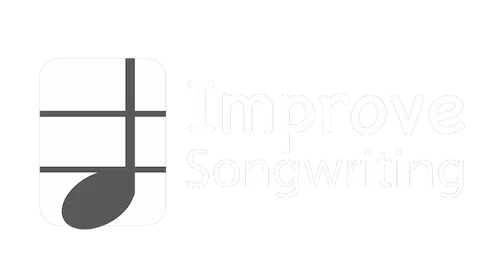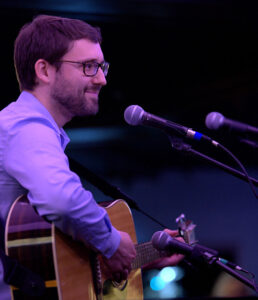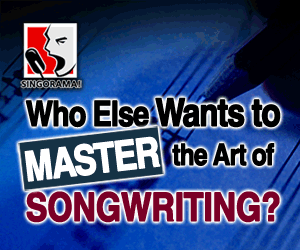When we listen to a song, it can often feel wrong if it doesn’t rhyme. But don’t start to fret if you can’t rhyme yet – it happens all the time!
(See what I did there? … Ahem.)
So, the question is:
Do songs have to rhyme?
Well, most songs in English tend to have some rhyming to them, but not ALL songs do. And even songs that do rhyme vary substantially in how much rhyme they have.
For example, some songs just rhyme in the chorus, while others rhyme almost every word throughout each section (such as Eminem’s Lose Yourself). You’ll have to decide what the best rhyme scheme is for your song (or if it should have one at all).
Before we discuss songs without rhyme schemes, let’s take a look at how it works in songs that do rhyme!
Improve your songwriting by mastering piano.
$49
ONLY
3 Different Types of Rhyme Schemes
Rhyme schemes vary in their complexity. If you’re looking for a lyric writing challenge, you can try to write intricate patterns with internal rhymes and end-line rhymes that dazzle your audience.
But for now, let’s just focus on three of the most basic rhyme schemes to get the gist of them.
1) AABB
Rhyme schemes have a special notation with letters to represent syllables that rhyme with each other. It’s sort of like rhyming algebra (good luck actually coming up with a word that rhymes with algebra, though).
For instance, in our first example, AABB means that the first two lines rhyme with each other (A with A), then the third and fourth lines rhyme with each other (B with B), and so on.
AABB is extremely common. You’ll notice it from Christmas carols like Hark! The Herald Angels Sing to Sugarhill Gang’s Rapper’s Delight all the way to ABBA’s Dancing Queen:
Friday night and the lights are low
Looking out for a place to go
If ABBA can use AABB, you can too. AABB is as easy as ABC!
This simple structure is an easy starting place for any song, so if you’re still new to the wonderful world of rhyming, AABB is a good default rhyme scheme for any song intro idea you have.
2) ABAB
Another easy way to rhyme in song is ABAB. In this case, you simply alternate the rhymes. This increases the tension – more on that later – and gives a nice release when you arrive at the corresponding rhymes.
For instance, Hello, Goodbye by the Beatles.
I say high, you say low
You say why and I say I don’t know
3) ABCB
Of course, you don’t have to have every line rhyme. That’s where ABCB comes in – you only rhyme the second and fourth line. This gives you a lot more freedom for the first and third line.
Let’s look at the opening lines of Hurt, by Nine Inch Nails (though I prefer the Johnny Cash version):
I hurt myself today
To see if I still feel
I focus on the pain
The only thing that’s real
All three of these approaches are common and fairly easy to implement. But don’t think for a moment these are ALL your options. There are dozens of other rhyme schemes to choose from (like AAAA in The Beatle’s Yesterday or AABCCB in their All My Loving). Plus, you can always make up your own!
So, now that you know a few rhyme schemes, let’s address the questions of why would you want to rhyme in song (or whether your song need to rhyme at all).
When to Rhyme in a Song
Think of your favorite song lyrics of all time. What do the songs you remember have in common?
I’d be willing to bet that any lyrics that have stuck with you also rhyme. It’s statistically a good bet – rhyming is so common, after all – but it also make sense. Rhymes are sticky.
Even as kids, we love repeating nursery rhymes ad nauseam, probably until our parents are sick of them. It’s part of our culture and maybe even our DNA as humans to enjoy rhymes.
If you know you want to rhyme, you need to know how to choose a rhyme scheme. I’ll give you some tips in a moment on how rhyme can help reinforce the message of the song, but I’d encourage you to not overthink rhyming at first.
The message you want to convey should come from your heart. Forcing rhymes that don’t really fit your message makes for awkward, corny, or cringey lyrics.
A bad rhyme is worse than no rhyme at all!
It’s difficult to write hard-and-fast rules about where to put your rhymes. There are so many different ways to do it!
But if you were to force my hand, a few rules of thumb would be:
- Where you want your audience’s attention
- On words/ideas that are related
- Where you want to enhance the musicality
1) Directing Your Listeners’ Attention
When choosing how and where to rhyme, think about what you want to draw attention to most of all.
Rhyme is like a spotlight. Just by speaking, we already put emphasis on some syllables and words. Rhyming goes beyond that – ending a line on a rhyme is like shining a spotlight on that word and dancing in front of it with sparklers yelling, “Look at this! It’s important!”
Again, this is why it’s crucial that you have a message and aren’t just throwing around rhymes aimlessly. Unless you’re making a rap song that’s only about wordplay and sound, rhyming on an unimportant word or phrase is just a pointless distraction.
Given that rhymes hype up certain lines, you should start out implementing rhymes where you want your audience most to remember your song. For most people, that’s going to be the chorus, but it could also be a different hook. (Not sure what the difference is? Check out our article on hook vs chorus.)
If your title line is in the chorus, try to rhyme with that and see what idea you can generate. Make a list of dozens of rhymes and see what stands out to you.
2) Relating different words and ideas together
It’s likely that the most memorable rhymes will be related to your title somehow. Perhaps you’ve found a rhyming synonym or antonym. Or maybe your title is a question and you can answer it with a rhyme. There are many ways to do it, but rhyming in any form will naturally connect two ideas.
Think back to the Beatles example about Hello, Goodbye. By rhyming “high/why” and “low/I don’t know”, the Beatles immediately make clear that the same mental connection between high and low (read: opposites/conflict) apply in the next line as well.
But try singing this:
You say high, I say low.
I say white, you say black.
It doesn’t have nearly the same impact, does it? And white and black are more clearly opposites than ‘why’ and ‘I don’t know’! The rhyming strengthens the contrast substantially by directly associating the second ideas with the first.
3) The Musicality of Rhyming Words and Phrases
Another point to consider when choosing where to implement rhyme is the musicality of it. Some songs lend themselves to rhyme for different reasons. If a rhyme feels natural with the swelling of your music, people might expect it. The first rhyme tends to increase tension and the listener is eager to hear the resolution, just like with minor and major chords.
There might be times to play around with this idea. In They Might Be Giant’s song Kiss Me, Son of God, they establish what feels like an AABB rhyme scheme with these two lines:
I look like Jesus, so they say
But Mr. Jesus is very far away
But they follow them up with:
Now you’re the only one here who can tell me if it’s true
That you love me and I love me
You probably expected the last words to be “and I love you,” but instead they chose not to rhyme with true. That makes it all the more shocking an admission. The character’s vanity is so strong that he doesn’t even respect the rhyme scheme!
And it can be difficult to break a rhyme scheme once you have one. Rhyme tends to make things naturally feel elevated to a higher, musical plane. It’s why we associate romance with poetry – think “roses are red, violets are blue” poems.
It’s sort of like the song equivalent to suspending your disbelief when watching a movie. There’s an implicit understanding that what you’re seeing isn’t quite real and you need to go along with it. When you rhyme in song, it no longer sounds like natural speech, but instead something different, possibly even grander than everyday speech.
That aesthetic might not be what you’re looking for, though. And if so, there are still examples of songs with no rhymes that get lots of airplay and critical acclaim.
Popular Songs Without Rhymes (That Are Still Good!)
Rhymes are fun and can convey meaning, but sometimes the bolder statement is not to rhyme. While it’s relatively uncommon, especially among the biggest hits, there are still successful songs out there that don’t rhyme much if at all.
For instance, take INXS’s Need You Tonight. If you don’t recognize it by name, you’ll recognize it by its famous synthesizer riff.
It’s an iconic riff that sticks with you long after you’ve heard the song. If INXS wanted someone to remember one thing about this song, do you think they’d rather the listener remember the lyrics or that sick riff? The answer to me is obvious: the riff! Rhyming lyrics would’ve competed for the spotlight.
Instead of rhyming its lyrics here, INXS played into the primal sound of the song. By having no rhyme scheme at all, they make the singer sound more genuine, like someone actually talking to you, or whispering in your ear that they’ve “got to let you know.”
The verses are terse, direct, raw, and repetitive. They help give context to what feeling the song is trying to convey, but then the lyrics step aside and let the riff do its magic. This is one of the best ways to write a non-rhyming song. If avoiding rhyme makes your song sound less formal than other songs, play up that aspect and have fun with it!
Another approach to writing songs without rhyme is to think of them as free verse poems. Free verse, or blank verse, is poetry that doesn’t rhyme. A great example of this would be the verses to Sheryl Crow’s All I Wanna Do, which were literally adapted from an existing free verse poem.
Even without rhyme, there are dozens of approaches to make compelling poetry in your song lyrics.
For starters, just because you aren’t using rhyme doesn’t mean you can’t make the words sound more special than everyday speech. You can play around with alliteration, assonance, and consonance.
Let’s look at these and see how they all show up in Cheap Trick’s non-rhyming song, Surrender:
- Alliteration: Starting multiple words (or stressed syllables) with the same consonant sound. For instance, the song Surrender: “Rolling numbers, Rock and Rollin.”
- Assonance: Repeating vowel sounds in many words in close proximity to each other. For example, “But mommy isn’t one of those” Note: assonance plays a crucial role in slant rhymes, which we’ll talk more about below.
- Consonance: Repeating a consonant sound in several words in close proximity to each other. Unlike alliteration, consonance can happen anywhere in the words. Cheap Trick does this here with the ‘d’ sound: “Now, I had heard the WACs recruited old maids for the war.”
Using Meter with Your Rhymes
Another tool you can embrace is varying the metrical patterns of the lines. There are dozens of combinations, from iambic pentameter (“If MU-sic BE the FOOD of LOVE, play ON”) to anapestic tetrameter (“Twas the NIGHT before CHRIST-mas and ALL through the HOUSE”).
The process of analyzing metrical patterns is called scansion and could be its own article (it very well might be someday, so stay tuned!), but suffice it to say that where you put emphasis on syllables is just as important without rhyme as with it.
Finally, let’s talk about slant rhyme, also called half rhyme. When we think about rhyming, most of us gravitate to perfect rhymes (ie “dance” and “chance”). But rhyme is actually a hazy spectrum. With enough assonance and similar sounding consonants, you can approximate rhyming in a variety of ways (like running/humming or fire/shiner). When you start broadening your mind to allow for slant rhymes, a world of lyrical opportunities opens up to you.
Take another non-rhyming hit song: Karma Police, by Radiohead. By no means can you assign a rhyme scheme to the lyrics, but thanks partially to Thom Yorke’s accent, he manages to make lines like these two sound rhyming:
Karma police, arrest this girl
Her Hitler hairdo is making me feel ill
“Girl” and “ill” make a slant rhyme. You can see how the concepts of assonance and consonance can help you make slant rhymes in your own music. If you write lines with a lot of assonance and consonance, you’re likely to start seeing a lot of internal slant rhymes.
By combining slant rhymes with other literary devices (notice the “H” alliteration in the Karma Police lyric above!), you can make interesting lyrics without any formal rhyme scheme at all!
Do Songs Have to Rhyme Wrap-up
By now, you should be aware that plenty of renowned and beloved songs don’t rhyme at all, while others only approximate rhyming through slant rhymes or devices like assonance and consonance.
If nothing else, I hope this gives you the confidence to branch out with your writing. It feels like a big deal for many lyricists and songwriters to move away from perfect rhymes, but there’s only so many times your listeners want to your “dance/chance,” “right/tonight,” or “part/heart.”
As a homework assignment (because who doesn’t like getting homework from a random guy on the internet?), try writing your own song a few different ways:
- With a particular rhyme scheme (AABB, ABAB, ABCB, etc.).
- With no rhyming at all.
- With half rhymes through assonance, consonance, and alliteration.
And now, a few parting words for inspiration: “I think there’s no better timing for me, than helping you NOW with your rhyming journey!”
Best of luck!
There’s a lot of creativity that comes from studying what already works. I like trying Piano for All as a course that helps you get familiar with the different types of musical genres, so you can pair them with your knowledge of lyrics and rhyme to create a new masterpiece!
Improve your songwriting by mastering piano.
$49
ONLY

![Do Songs Have to Rhyme? [Plus 3 Rhyme Schemes to Know!]](https://improvesongwriting.com/wp-content/uploads/2021/09/Do-songs-have-to-rhyme-1-1280x640.jpg)






